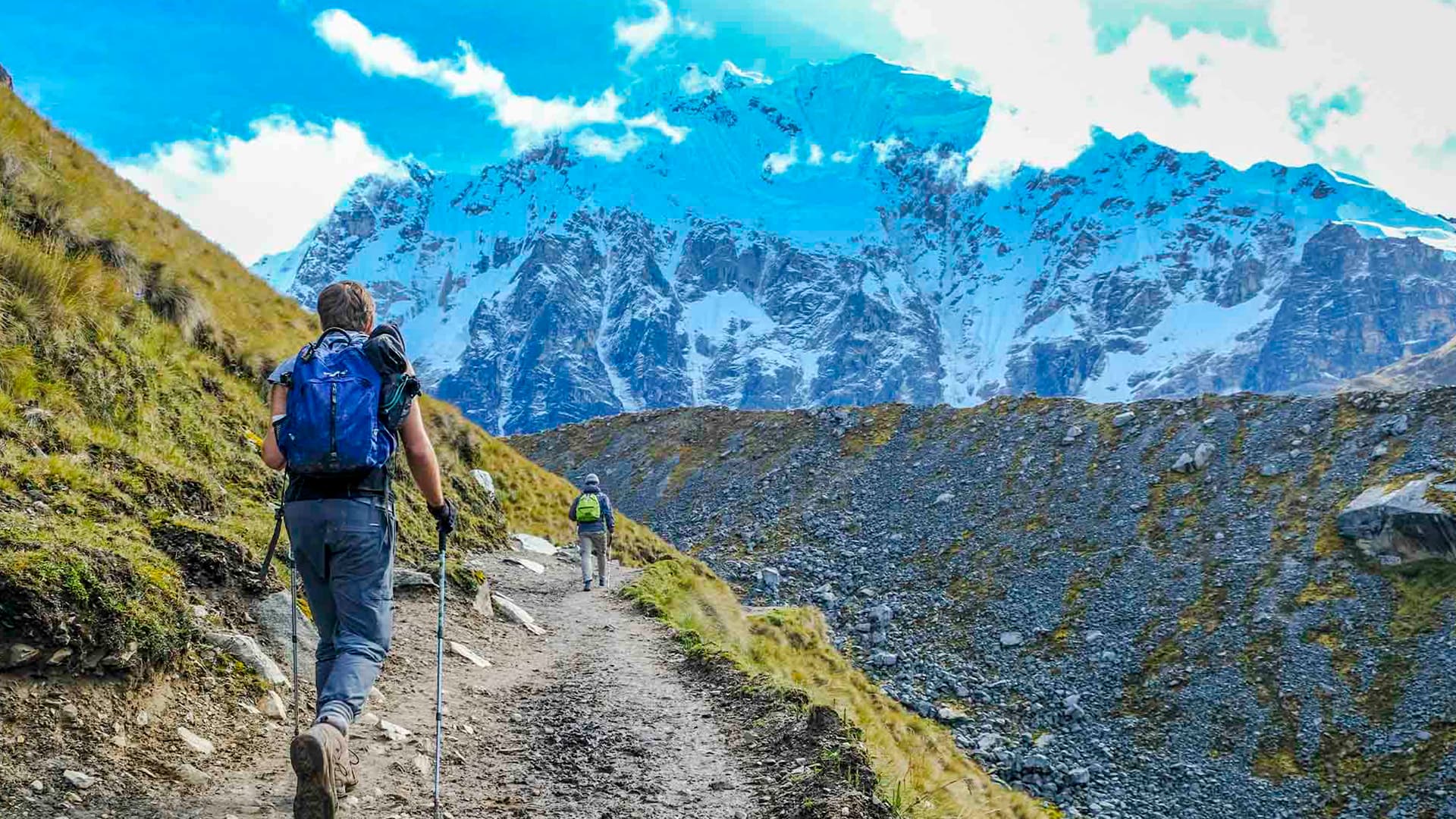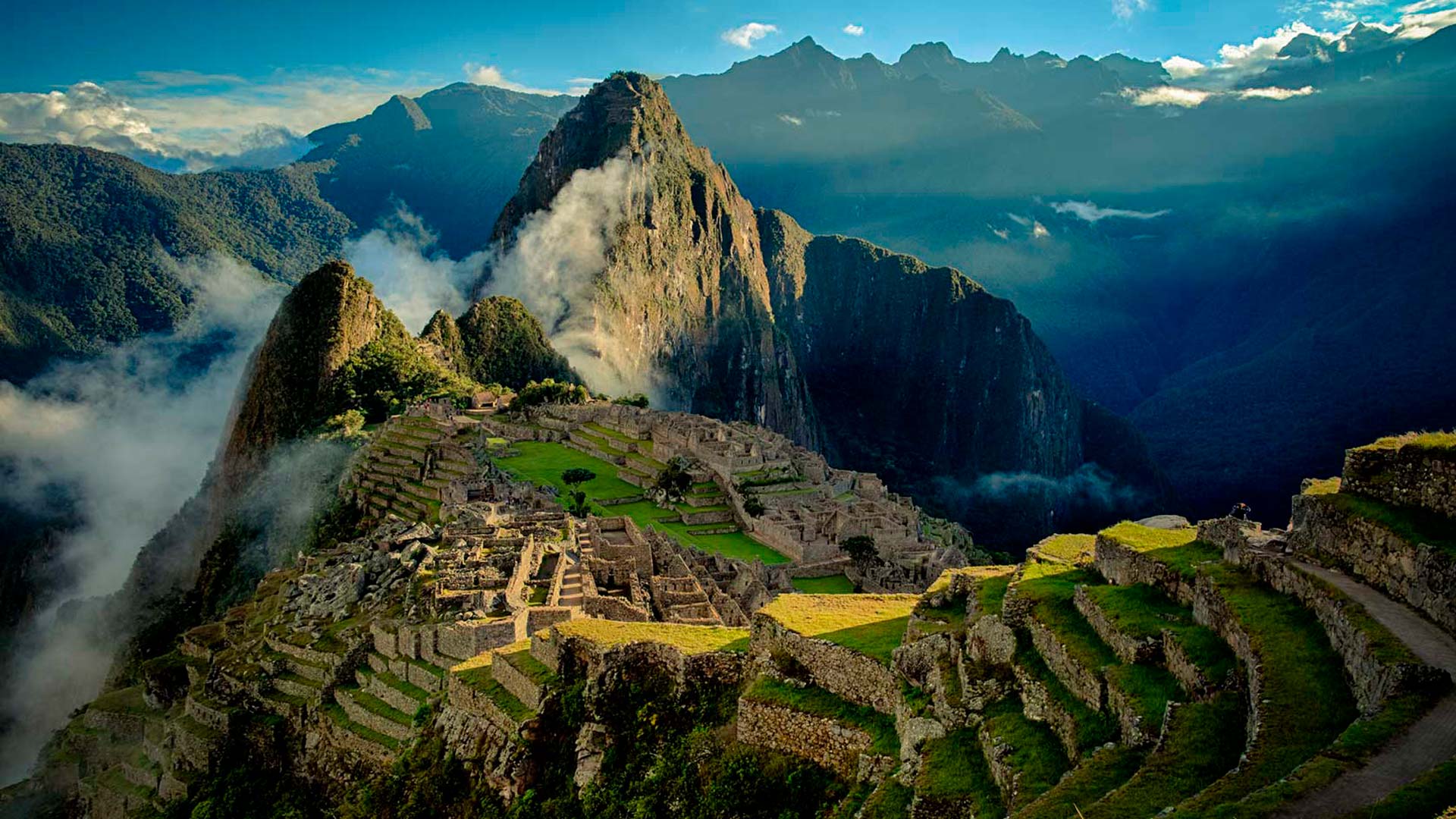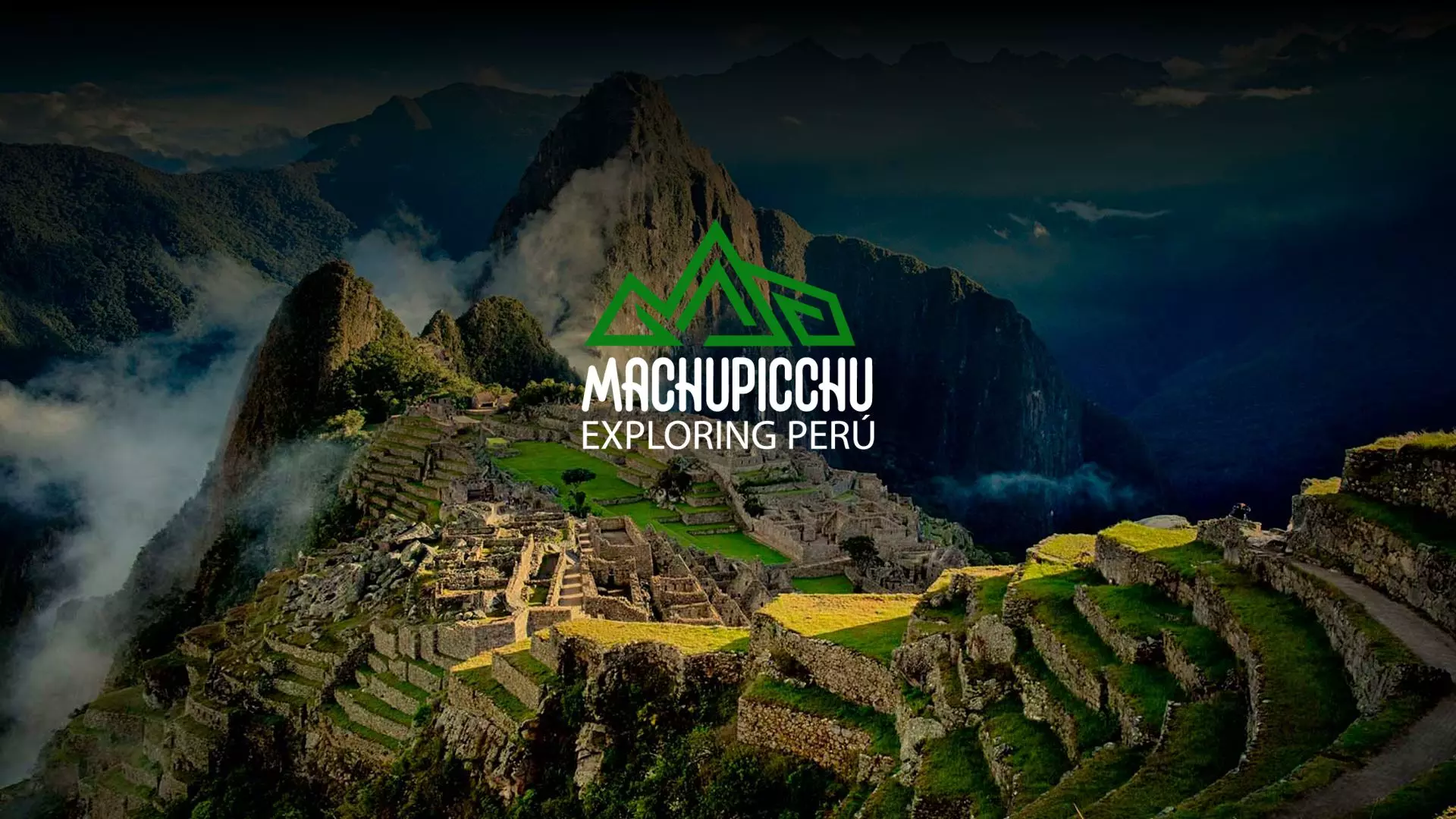Menu



9 Days / 8 Nights
50 miles
Moderate
3300 - 5000 msnm
Salkantay Trek
Up to 8 people
Thinking about Trekking to Machu Picchu?. The first thing that came to mind was probably to hike the Inca Trail to Machu Picchu.
Because of excessive crowds the Peruvian government decided not only to limit daily access but also to impose strict Inca Trail Regulations. We understand how frustrating it is to not be able to get a permit because you didn’t book 4 months in advance and there are no permits left.
THIS SALKANTAY TREK WAS RECENTLY NAMED AMONG THE 25 BEST TREKS IN THE WORLD, BY NATIONAL GEOGRAPHIC ADVENTURE TRAVEL MAGAZINE.
Is a trek open to everybody, with no limitation on spaces or permits (at least for now). Connecting the city of Mollepata, Cusco with Machu Picchu, the Salkantay Trek is an ancient and remote footpath located in the same region as the Inca Trail where massive snow capped mountains collide with lush tropical rain forests.
Located less than fifty miles northwest of the city of Cusco in south central Peru by the Cordillera Vilcabamba and rising to 6271 meters above sea level (20574 ft) Mt.
Salkantay is an outstanding glacier-capped summit worshipped for thousands of years by local indians. The name Salkantay is a quechua word meaning “Savage Mountain”.
SALKANTAY TREK
Our classic Salkantay Trek is a custom-designed alternative to the traditional Inca Trail. Off the beaten path, this is a cutting edge experience for adventure travelers looking for a little more privacy and authenticity. With more spectacular vistas, the Salkantay to Machu Picchu Trek offers the solitude and quiet contemplation such a sacred path deserves.
PLEASE NOTE: WE ARE TAKING THE PATH OF MARCOCASA TO GET BETTER VIEWS AND WE ARE SKIPPING THE DUSTY ROAD OF THE FIRST DAY AS WELL HIKE TO LAKE HUMANTAY WITH VIEWS OF MT. SALKANTAY, A SACRED MOUNTAIN IN INCAN MYTHOLOGY.
WE ARE TAKING THE ORIGINAL INCA TRAIL TO LLACTAPATA TO SEE THE GREAT VIEW OF MACHUPICCHU FROM A DISTANCE. SOMETHING UNIQUE.
Meet & greet with other guests where you receive important information for a great trekking experience.
We pick you up from your hotel and then we go the bus station and travel by bus for about 3 hours to Mollepata. A 3 hour walk will take us to Cruzpata where we will have lunch with panoramic views of beautiful snow-capped mountains (Humantay; 4120m/13500ft and Salkantay; 6271m/20575ft) – just the start! We will begin our trek towards Soraypamapa, our first campsite (3800 m/11750ft; the highest and coldest campsite of the trip) taking in the beautiful landscape along the way
Total distance: 15 km (approx.)
Estimated walking time: 7-8 hours
Maximum altitude point: 3,800 m (approx.)
Campsite altitude: 3,800 m (approx.)
We will have breakfast at around 5.30am and begin our walk to the highest pass on this trek (4650m/15200ft) located halfway between 2 huge mountains; Salkantay on the right and Tucarhuay on the left. From the pass, the views of the 2 snow-capped mountains are incredible. There is a possibility of snow here.
After a rest, we will continue our walk (downhill) through a dramatic cloud forest towards Huayracpunku, where we will have lunch. We hike again after lunch in the direction of the start of the jungle until we reach our second campsite, chaullay or Colcapampa (3000m/9800ft).
Total distance: 19 km (approx.)
Estimated walking time: 8 – 9 hours
Maximum altitude point: 4,650 m (approx.)
Campsite altitude: 2,750 m (aprox.)
After breakfast, at 6.30am, we start trekking for the day through the upper jungle crossing the Lluskamayo River and a variety of little brooks to reach La Playa walking about 6 hours . Today we will pass through valleys and have wonderful views of waterfalls, tropical fruits ,plants and as soon as we are at la playa place where we are going to camp, on the other hand the horses will go back to Mollepata. from here there are an optional thing to do so we can take a local bus to drive one hour to get santa teresa where we can enjoy the natural hots pring ( bus fares and entrance fees to the the natural hots pring is not included in this tour
Total distance: 16 km (approx.)
Estimated walking time: 6-7 hours
Maximum altitude point: 2750u (approx.)
Campsite altitude: 1,600 m (approx.)
We will have breakfast at 8am and leave our campsite at la Playa we will walk for about 20 minutes to get to Lucmabamba so wi wil do the original trail of Lacctapata after we arrive to Hydrolectric where we are going to have lunch then we continue walking, passing a variety of crop plantations, coca, banana we will be walking about two and half hours along the train road till reaching Aguas Calientes town where we will spend the night in a hostal.
In Aguas Calientes, you can take advantage of the thermal springs in the town (entrance 10 soles) a real treat after finishing the trek
Total distance: 12 km (approx.)
Estimated walking time: 8 – 10 hours
Maximum altitude point: 1,600 m (approx.)
Hostel(aguas calientes) altitude: 1,900 m (approx.
We wake up early morning about 4 am to then to 4:30 to have the breakfast and leave to walk up to machupichu which takes one and half hours up to machupicchu but there is another option to catch the first bus which leaves 5:30 to Machu Picchu (25-minutes long ) in order to appreciate the magnificent city as the sun is rising. A walking tour (approximately 2 hours) is given by your Guide and after this you can explore the mysterious city by yourselves. If you still have energy you can also climb Huayna Picchu (2720m/8890ft)!!!Ittakes45minutestoreachthetop. You will meet your guide in Aguas Calientes (it can be reached by bus or on foot) to be given your train tickets back to Cusco or ollantaytambo . The first train usually leaves at 15.55 and we will arrive back in Cusco at about 20.20.or the second train which leaves 4:20 and goes to ollantaytambo where someone will be waiting for you with your guides name who will take you to takea bus to cusco. If desired, an extra night in Aguas Calientes town can be arranged. (Please let us know whether you would like to stay an extra night when booking your tour.)
Total distance: 4 km (approx.)
Estimated walking time: 1- 2 hours
Maximum altitude point: 2,700m (approx.)
Your guide will pick you up from the airport or from the bus station. You’ll then go to our office based in Puerto Maldonado to register (passport number and flight number). Then, you’ll take the boat down Madre de Dios Rver to get to our Lodge. After a one-hour boat ride, you’ll arrive at the Lodge where you’ll be given a fresh exotic fruit juice. You’ll get the key to your room.
After resting for a bit, you’ll go for a two-hour walk in the jungle. Your guide will tell you about the lush vegetation (some trees are 500 years old). You’ll also have the chance to see birds (parrots, macaws…), monkeys snakes, butterflies… You’ll discover our wonderful jungle.
In th evening, you and your guide will go for a boat ride on Madre de Dios River to look for caimans. You’ll spot the shiny red eyes of the caimans with a flashlight. You might also observe capibaras, the biggest rodents in the world. They can weight up to 60 kilos.
Back at the Lodge you will be served dinner.
You’ll wake up early (5.30am) to get to a canopy, that is 40 metres high. From up there you’ll see different species of birds, such as macaws or Eagles.
After breakfast, you’ll go to the Monkey Island, which is jsut across from our Lodge. There, you’ll see different kind of monkeys. Then , you’ll take the boat again to get to the Tambopata National Reserve. After a five kilometre walk, you’ll discover the amazing Sandoval Lake. It’s a real wonder, where you’ll see a great varierty of animals, such as birds, monkeys, sloths…After a typical lunch, you’ll go for a boat ride on the lake to see the animals from closer. If it’s a lucky day, you might see giant otters (Animals in danger of extinctiuon) or very big black caimans (the biggest one registered is five metre long).
You’ll be on your way back to the Lodge at sunset.
Dinner. Free time.
After breakfast, you’ll go for a short walk into the jungle to get to a small river where you’ll fish piranhas. You’ll be back at the Lodge for lunch time. After a nap, you’ll be taken back into the jungle for a hallenge. You’ll be experiencing zip-lining, tree-climbing, etc… Of course, a specialist will be with you to tell you evething you need to know about security to experience a safe but exciting adventure! Feel the adrenaline! You’ll love it!
Dinner.
we wake up early to do a birdwatching activitie breakfast you’ll head back to the city to visit the local market and discover some tropical fruits. Your guide will take you to the airport or to the bus station.
IMPORTANT NOTE:
Appropriate clothing along this hike
Hiking pants and T-shirts are recommended during the day, complemented by sweaters, fleeces and waterproof jackets. It is very convenient to have light raingear available in the daypack (rain poncho or jacket and/or rain pants) as the weather changes easily and rains can suddenly occur. At night, warm clothing is required, down jackets can be useful, otherwise a fleece and a jacket. During the fourth day (if sunny) and in Machupicchu, convertible hiking pants are useful, as can be switched into shorts if necessary. Machupicchu has a warm climate, getting only cold at night. The rest of necessary implements are included in the“What we recommend that you bring” list.
Salkantay Trek + Jungle Expeditions 9D 2016 – 2017
DISCOUNTS:
How long does it take to get to Peru?
To Lima on a non-stop flight (recommended):
From Miami 5 1/2 hours
From New York 8 hours
From Los Angeles 8 1/2 hours
When is the best time to go?
This is a difficult question to answer as Peru has a huge variety of weather conditions. We would say travelers can visit Peru any time of the year !
Dry season runs from May to November and this is typically the time that is most recommended. However, this is also the cooler time of year. Nighttime temperatures can drop to below freezing at the height of the dry season. June, July and August are the most popular months to visit so you will tend to encounter much larger crowds during these months.
In the wet season (December to April), you can expect showers three to four afternoons a week. For travelers that don’t mind a little drizzle and muddy trails, this time of year offers smaller crowds and greener hillsides, with wildflowers and orchids often in bloom. The shoulder seasons, April to June or September to November can often provide the best of both worlds. They typically have fewer crowds and warmer temperatures than the height of the dry season, but still tend to have relatively little rain. For more information, check out our Peru Weather page.
What entry documents do i need?
U.S. citizens need a valid passport and an entry form-tourist card which is provided by your air carrier either at the ticket counter when checking in for your flight to Peru or once on-board. (NOTE: Other nationalities should check with the nearest Peruvian Consulate to determine correct entry requirements.)
Is it safe to travel in Peru?
Definitely. We tend to hear the very worst news from Latin America. Helpful people and extraordinary culture. Most crime is opportunistic and not violent buy of course, it is possible to be in the wrong place at the wrong time. Care and common sense will nearly always prevail.
The Sendero Luminoso is no longer active.
What type of transportation is used?
Our escorted tours utilize a variety of transportation including private vans/ cars, comfortable tourist buses, flights, canoes, etc. We use a mix of private/ public transportation to provide travelers with the safest and most efficient transportation in each area. Occasionally, we may include non-typical transportation modes (rickshaw, bicycle taxi, “chicken bus”, etc.) for short distances to give travelers a sense of local flavor.
Will the altitude affect me?
When travelling throughout the Andes in Peru some people will suffer some effects of altitude sickness. If you plan to hike the Salkantay Trek we recommend arriving 2 or 3 days before the start to acclimatize and rest.
What is the best thing to do in the event of altitude sickness?
Wherever possible “go down”. But, if you are staying in Cusco, you may still feel the effects. The best advice is to sleep, take plenty of fluids and you could also try coca tea. The porters chew coca leaves wrapped around a black resin called llipta. When you are actually walking and active (especially on day two of the trail), this may help since it dilates vessels to increase the blood flow to the parts of the body that need it.
Will I get high on coca leaves?
No – sorry! Although cocaine can be extracted from the leaves, it requires a long process involving acids and distilling. Your body simply does not have the capacity to extract much from the leaves.
Do you require a deposit?
Yes. We require a non-refundable booking deposit of US$225 for all treks and US$450 for al other tours.
back to top
Is the Salkantay Trek difficult?
You know the answer to this one: it depends! You reach 4600m on the second day after climbing for the best part of the day. Especially if you are within your first five days at altitude, this may give you headaches and shortness of breath. Don’t forget that even people who live in Cusco (at 3300m) still get short of breath.
What do I need to bring on the trek?
Backpack, sleeping bag, mattress (we will provide you with this), rain jacket, strong footwear (walking boots are recommended as they provide support to the ankle which reduces the risk of injury especially when trekking in the wet season (December – March). However it is important that your boots are comfortable and well worn-in and not brand new. Many people prefer to trek in tennis shoes but extra care should be taken. We do not recommend trekking in sandals. One complete change of clothing, sweater, jacket (something warm), water bottle and sterilizing tablets (Micropur are recommended and can be bought in local pharmacies in Cusco), flashlight and batteries, broad-brim or peaked cap, sunblock, insect repellent, toiletries and toilet paper, selection of small snacks, chocolate, dried fruit, biscuits etc, camera and plenty of film. You also have to bring your original passport with you on the trek.
Should I request an extra horse?
It is better to request a horse before you go on the trail rather than realize halfway through that you’re not enjoying carrying your pack at this altitude and want some help. Additional horses are just to carry load.
What do we do for water along the Salkantay Trek?
At meal times we will give you teas, coffees etc to drink. You’ll come across several mountain springs, fountains or small streams along the trail where you can fill up your water bottle. Take a bottle of at least 1½ liter capacity per person. Although the water looks clean, it is always safer to use sterilizing tablets or a water filter.With these tablets you have to wait between 30 and 40 minutes before drinking. Bottled mineral water can also be taken from Cusco or bought at Mollepata or Santa Teresa.
What happens if I arrive at Machu Picchu and then decide to stay an extra night, can I change my train ticket?
It is still possible to make changes to your return train ticket if you decide to stay an extra night at Aguas Calientes. You will have to take your train ticket personally to the train station in Aguas Calientes and ask them to change the return date of your ticket. You will probably be asked to pay an extra administrative fee and changing the ticket will be subject to availability of spaces the following day. If you change your ticket for a cheaper service then you will not be refunded the difference!.
What training do you provide for your staff on environmental practices?
Our guide teams have been trained in first aid and rescue and are regularly updated through seminars and courses in their respective fields. All of our trekking staff receives regular briefings on how to best comply with the Salcantay Trek Trail and Machu Picchu Sanctuary Regulations as well as on environmental awareness.
Our Credo in Nature
We are great believers in leaving the areas that we visit in as untouched a condition as is possible. We encourage everyone who travels with us to respect the land, the people, and their fellow travelers. This type of focus leads to amazing experiences and insights that bring a sense of satisfaction, which is difficult to create any other way, so be thinking responsibility, consideration, and FUN!
What you do to minimise environmental impacts on the Salkantay Trek?
Our Environmental Management Policy and Commitment considers running our operations in a responsible way, according to the following:
Selective disposal of garbage (organic & inorganic)

© 2023 Machupicchu Exploring Peru. All Rights Reserved Diseñado por WebCodePeru
WhatsApp us